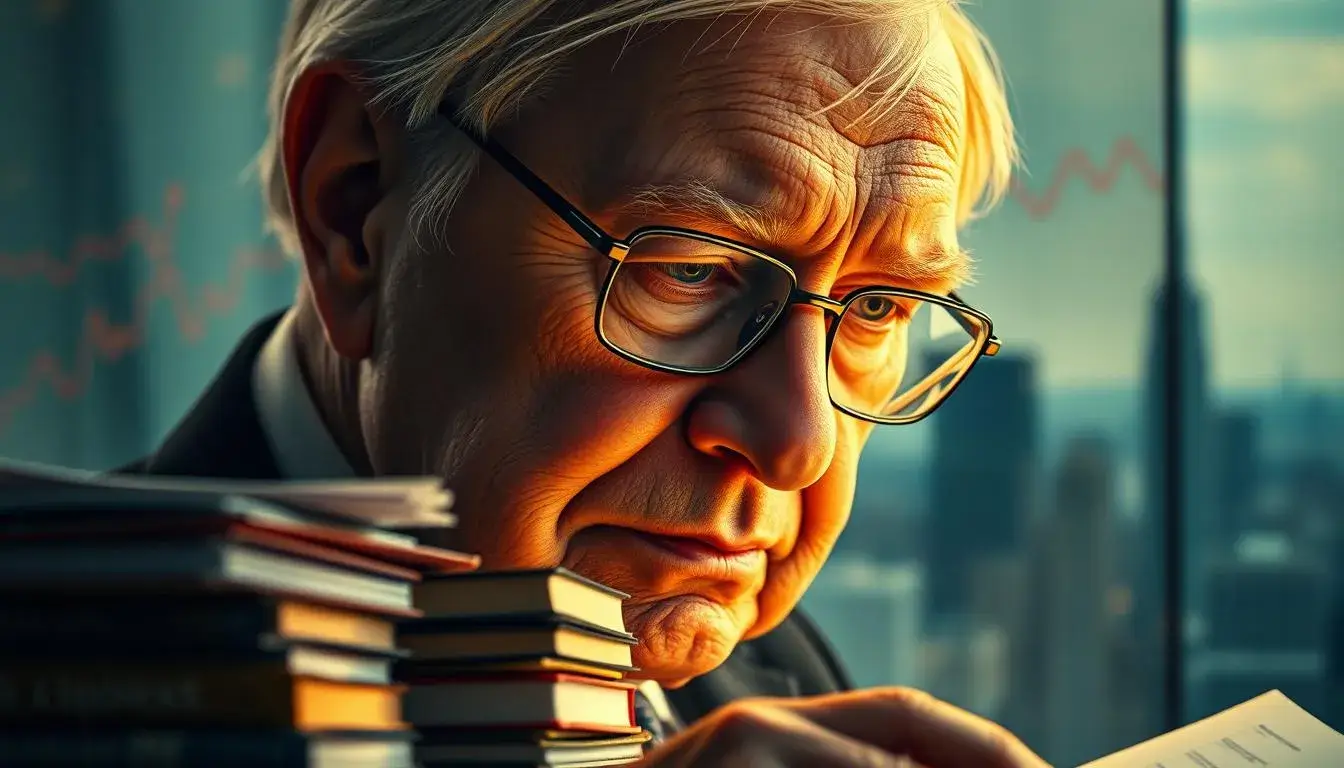What if the next economic crisis could make you a millionaire? Warren Buffett made his fortune by turning market crashes into opportunities. When Lehman Brothers went bankrupt in 2008, the S&P 500 later jumped 130%.
This shows Buffett’s rule: bad news is a golden investing signal. His 2008 strategy was to buy top companies when fear lowers their prices.
Buffett’s mantra—“Be fearful when others are greedy”—worked wonders. An Apple stock purchase in 2008 now holds nine times its value. Even as markets fell after 2008, his patience paid off.
Today, his approach remains a blueprint: downturns aren’t disasters—they’re discounts on America’s future.
Key Takeaways
- Warren Buffett’s 2008 strategy turned crises into S&P 500 gains of 130%.
- Investing in strong companies during fear, like Apple, yields massive growth.
- Buffett’s “fear vs. greed” philosophy guides long-term wealth building.
- Market drops create buying opportunities for disciplined investors.
- History shows recovery follows every crash, rewarding patient investors.
The Counterintuitive Genius of Warren Buffett
Warren Buffett’s success comes from doing the opposite of what others do. When markets crash, he sees chances that others don’t. His advice is to be scared when everyone else is greedy.
Why the “Oracle of Omaha” Smiles When Markets Tumble
“The time to get interested is when no one else is.”
In 2008, Buffett put $5 billion into Bank of America during a tough time. This move showed his belief in finding value when others are scared. Since 2000, the S&P 500 has grown 200%, showing his strategy pays off.
The Psychological Edge That Sets Buffett Apart
- Focus on fundamentals, not fear-driven headlines
- Adhere to “Rule No. 1: Never lose money” to protect capital
- Seek companies with “competitive advantages” like Coca-Cola and Apple
Buffett doesn’t let fear control him. He looks for long-term gains. His 2025 letter said patience and discipline are key to growing wealth.
Fear as the Ultimate Wealth Creator
Market downturns are chances to buy. Buffett uses a “margin of safety” to find good deals. When fear is high, prices are low, making it easier for smart investors to buy.
| Short-Term Fear Effects | Long-Term Gains |
|---|---|
| Panic selling | Undervalued stocks |
| Media-driven panic | Compounding growth |
| Temporary losses | Historic portfolio gains |
Warren Buffett turns crises into chances. By ignoring fear and sticking to timeless rules, investors can grow wealth. His story from paper boy to billionaire shows the power of smart thinking.
When Others Panic, Opportunity Knocks
In times of crisis, the market often reacts too quickly. Buffett said in 2018, “A willingness to look unimaginative” can reveal hidden opportunity. History shows that fear-driven selloffs create buying windows for those who stay calm.
“Investors should remember that market fluctuations are your friend, not your enemy.” – Warren Buffett
Take the 2008 financial crisis as an example. The S&P 500 fell to levels seen in 2018, but Buffett invested $5 billion in Bank of America. In 2020, companies like Zoom soared as remote work needs grew. These moments show timeless patterns:
- Market drops often overcorrect, pricing quality assets below intrinsic value
- Emotional selling creates buying opportunities for disciplined investors
- History repeats – every major crisis since 1929 has been followed by recovery
Buffett’s success comes from seeing value beyond temporary panic. When the Dow Jones fell 23% in 1987, long-term holders saw their investments grow fourfold over 13 years. Today, investors should look for today’s overlooked opportunity zones. Consider sectors like renewable energy or tech infrastructure – areas that thrive through disruptions.
Remember: The next crisis won’t be the last. By studying past patterns and maintaining emotional control, ordinary investors can turn fear-driven market declines into wealth-building catalysts. As Buffett teaches, “Be fearful when others are greedy, and greedy when others are fearful.”
Historic Market Crashes That Built Buffett’s Fortune
Warren Buffett made his biggest gains during tough times. He saw opportunities when others panicked. His success shows that the worst times for stocks can lead to huge profits.
The 2008 Financial Crisis: Buffett’s $5 Billion Bank of America Masterstroke
In 2008, Buffett invested $5 billion in Bank of America when banks were failing. The S&P 500 soared 130% in 14 years after Lehman Brothers went under. Apple shares he bought grew nine times, not counting dividends. This showed his wisdom: “Be fearful when others are greedy.”
COVID-19’s Plunge: Positioning for Recovery
- Berkshire sold $134B of stocks in 2024, boosting cash to $334B
- Apple, now 49% of his portfolio, rose 27% in 2024 despite share cuts
- Bank of America holdings dropped 34%, but his long-term focus outperformed short-term fears
Lessons from Crisis Investments
Buffett’s strategy is simple: stocks fall faster than they rise, fear offers great deals, and cash is power. When markets crash, he buys. His $334B cash reserve today shows he’s ready for the next crisis.
Transforming Bad News Into Your Financial Advantage
Market downturns might seem like obstacles, but they often lead to long-term wealth. Warren Buffett’s $350 billion cash reserve at Berkshire Hathaway shows his readiness to invest when others pull back. Here’s how to think like him.
Building Your Crisis Investment Strategy
Begin by preparing for the next crisis. Investing during fear needs a solid plan. Buffett suggests testing your portfolio to handle drops of 50% or more. Keep cash ready and avoid selling in panic, like he did in 2008.

Warren Buffett’s Criteria for Crisis Buying
- Look for companies with lasting risk-adjusted value, not just short-term gains
- Seek businesses with strong competitive advantages and loyal customers
- Check the quality of management—Buffett learned from his Dexter Shoe Company loss
The Patience Principle: Timing Your Market Entry
“Be fearful when others are greedy, and greedy when others are fearful.”
Buffett waited months after his 2008 op-ed before the S&P 500 hit its low. Patience allows you to buy at the best prices. His Tesco shares mistake taught him to wait for the right time, like stabilized earnings or reduced volatility.
Remember, the Nasdaq’s 2020 lows were opportunities for those who stayed disciplined. Use crises to buy quality assets at discounts, then hold them through ups and downs. History shows equities outperform cash in the long run.
Developing the Millionaire Mindset During Market Turmoil
Success in turbulent markets depends on mastering your mind. Warren Buffett’s $154.1 billion fortune came from more than just picking stocks. It came from training his mind to see opportunities in chaos.
Emotional traps like fear of loss or panic selling can ruin most investors. Buffett even made mistakes, like his Tesco blunder:
“An attentive investor…mistake with this investment by dawdling,”
he said. These moments show that success needs constant mental discipline.
- Track decisions in a journal to dissect emotional reactions.
- Pre-set rules to override impulsive reactions.
- Focus on intrinsic value metrics, not short-term noise.
Market crashes reveal hidden gems, offering rare chances for those brave enough. Buffett’s 29.5% annual returns during his partnership era came from this insight. His advice—“be fearful when others are greedy”—views volatility as a chance for growth.
Mastering this mindset means learning from mistakes, not seeing them as failures. By sticking to fundamentals and patience, any investor can follow Buffett’s path. Success in crises comes from mental preparation, not luck.
Conclusion: Embracing Buffett’s Contrarian Path to Wealth
Warren Buffett shows us that downturns are chances, not disasters. He buys quality companies when others are scared. This strategy has made him rich.
In 2008, he put $5 billion into Goldman Sachs, despite criticism. Later, his $50 billion Apple investment proved his smart timing. These moves show his ability to adapt to changing markets.
Buffett values what’s real over what’s fleeting. Even his mistakes, like losing $400 million on Dexter Shoes, taught him to steer clear of overpriced areas. Berkshire Hathaway’s 20.1% annual returns since 1965 show his strategy works.
His advice is to fear when others are greedy. This means buying strong companies at low prices during downturns. It’s a timeless strategy.
Today, investors can learn from Buffett’s approach. He bought Amazon in 2017, despite its high P/E ratio. This contrasts with his decision to sell Walmart, showing the importance of careful analysis.
Buffett’s $31,500 home purchase and his charity work show his humility. He focuses on long-term value, not short-term gains.
Following Buffett means being willing to face discomfort. When everyone is worried, look for undervalued opportunities. History shows markets bounce back, but only those who study companies’ fundamentals do well.
The key to wealth isn’t avoiding all risks. It’s finding mispriced assets during tough times. Buffett’s success isn’t about being perfect. It’s about sticking to timeless principles through every market cycle.
FAQ
What is Warren Buffett’s investment philosophy?
Warren Buffett looks at market downturns as great chances, not problems. He thinks crises are the best times to buy quality companies at lower prices. This is key for long-term investors.
How did Buffett benefit from the 2008 financial crisis?
In 2008, Buffett made smart moves, like investing billion in Bank of America. He took advantage of the market’s panic, leading to big gains when the economy got better.
What mindset does Buffett recommend for ordinary investors?
Buffett suggests that investors need to stay calm and focused during market ups and downs. By being disciplined and detached, and spotting good deals, they can grow their wealth.
How does Buffett identify companies to invest in during crises?
Buffett looks at a company’s basics, like its edge in the market, its leaders, and its standing. He uses these to find companies that are unfairly priced down.
What practical advice does Buffett provide for crisis investing?
Buffett advises to have a plan for crisis investing, focus on the company’s core, and wait for the right time to invest. It’s important to know that market prices don’t always reflect a company’s true value.
How can investors develop mental resilience during downturns?
To build mental toughness, investors should watch out for fear and loss aversion. Keeping an investment journal and setting clear rules can help make smart choices, even when the market is chaotic.
How has Buffett’s success shaped his reputation as an investor?
Buffett is known as the “Oracle of Omaha” for his grasp of market psychology and business basics. His success in making money when others lose it has made him a legend, inspiring many to follow his lead.



